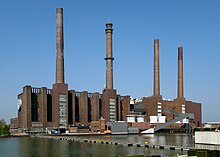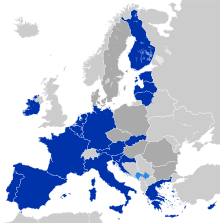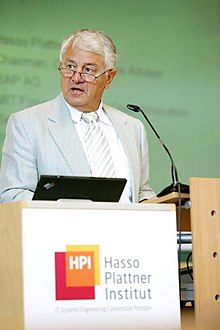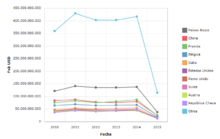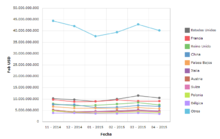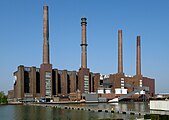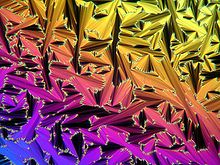Economy of germany
The Germany's economy is the fourth most powerful economy in the world after the United States, China and Japan, and fifth by GDP (PPP). The country is considered the economic engine of the European Union (EU). In 2014, Germany posted the largest trade surplus in the world at $285 billion, making it the world's largest capital exporter. Germany is the third largest exporter in the world with 1,511,000 million dollars exported in 2014. Exports represent 41% of national production. The service sector contributes around 70% of total GDP, industry 29.1%, and agriculture 0.9%. The main goods exported from Germany are vehicles, machinery, chemicals, electronics, pharmaceuticals, transportation equipment, basic metals, foodstuffs, rubber, and plastics.
Socio-economic policy in Germany is based on the concept of the social market economy.
Germany is the first major industrialized country in the world to commit to the renewable energy transition called Energiewende. Germany is the leading producer of wind turbines and solar power technology in the world. More than 1.5 million renewable energy generation plants have been installed in Germany during the last 25 years. Renewable energies currently produce more than 27% of the total electricity consumed in Germany. Germany's goal is to achieve greenhouse gas neutrality by 2045.
99% of all German companies belong to the so-called Mittelstand, small and medium-sized family-owned companies. Of the world's 500 largest publicly traded companies, 50 are headquartered in Germany. By market capitalization, 20 German-based companies are in the Fortune Global 500 including Volkswagen, Allianz, Daimler, BMW, Siemens, BASF, Munich Re, E.ON, Bayer, and RWE.
Germany is the largest producer of lignite in the world. Germany is also rich in timber, iron, potash, salt, uranium, nickel, copper, and natural gas. Energy in Germany is obtained mainly from fossil fuels, followed by nuclear energy, and by renewable energies such as biomass (wood and biofuels), wind, hydro and solar.
Germany is the most important location for trade fairs in the world. Around two thirds of the world's largest trade fairs take place in Germany. The largest annual fairs and international congresses take place in various German cities, such as Hannover, Munich, Frankfurt am Main and Berlin.
Germany is the only country among the top five arms exporters that is not a permanent member of the United Nations Security Council.
At the beginning of 2020, Germany was close to full employment. However, during the COVID-19 pandemic, the number of unemployed increased significantly, reaching around 2.8 million in mid-2020. In addition, many people were working part-time.
History
Industrialization
The Industrial Revolution in Germany came almost a century later than in Britain, France and Belgium, as Germany became a unified country in the 19th century XIX.
The establishment of the Zollverein (German customs union) and the creation of railway systems were the main drivers of the industrial revolution and political union. In 1834, the tariff barriers between the German states were removed. In 1835, the first German railway was built linking Dresden and Leipzig, and it was so successful that the 1840s saw "train fever" in all German states. Over time, other German states joined the customs union and began to link their railway systems, which began to connect all corners of Germany. The creation of a German-wide railway system in the 1840s intensified economic development that opened up new markets for local products, increased demand for skilled engineers, architects, and laborers, and stimulated investment in coal and iron..
With the defeat of Second Empire France in 1870 and the creation of the German Empire in 1871, industrialization was further stimulated. The reaction to Napoleon I's conquests of the German states during the time of the French Revolution produced important institutional reforms, including the removal of feudal restrictions on the sale of large estates, the reduction of the power of the guilds in the cities, and the introduction of a new, more efficient commercial law. However, political decisions about the economy of the German Empire were still largely controlled by a coalition of 'rye and iron', i.e. the Junker landlords from the east and heavy industry from the west.
In the early 1900s, Germany was a world leader in industrialization. Between 1895 and 1907, the number of workers employed in machine building doubled from half a million to over a million. Germany also witnessed unprecedented population growth from 35 million in 1850 to 67,000,000 in 1913. The rapid move towards industrial maturity led to a drastic change in Germany's economic status from being an importer of technology to be a large exporter of finished products. By 1913, Germany had come to dominate all European markets and by 1914, it had become one of the three largest exporters in the world.
Third Reich
The Nazis came to power while unemployment was very high, but full employment was achieved later thanks to massive public programs like the Reichsbahn, Reichspost or Reichsautobahn.
| Date | Unemployed | Employees |
|---|---|---|
| August 1932 | 5.2 | 12.8 |
| August 1933 | 4.1 | 14.1 |
| August 1934 | 2.4 | 15.9 |
| August 1935 | 1.7 | 17.1 |
Expansionary economic and fiscal policies after the financial crisis of 1931 (as Germany was off the gold standard) were advised by the non-Nazi Minister of Finance, Hjalmar Schacht, who in 1933 became president of the central bank. Hjalmar Schacht left the post in 1938 and was succeeded by Hermann Göring.
The Third Reich's trade policies were aimed at self-sufficiency, but with a lack of raw materials, Germany would have to maintain trade ties, but on bilateral preferences, currency controls, import quotas, and export subsidies under what was called the "New Plan" (Plan de Neuer) of September 19, 1934. The "New Plan" It was based on trade with less developed countries that would exchange raw materials for German industrial products. This policy is known as the Grosswirtschaftsraum ("greater economic area") policy.
Eventually, the Nazi party developed strong relationships with big business and unions, abolished in 1933 in order to form the National Labor Service (RAD) and the German Labor Front (DAF) to adjust working hours.
West Germany
With the replacement of the Reichsmark by the Deutsche Mark as legal tender, there was an enduring period of low inflation and rapid industrial growth supervised by the government led by Chancellor Konrad Adenauer and his Minister of the Economy, Ludwig Erhard, raising West Germany from the total devastation of war to become one of the most developed nations in modern Europe.
The Marshall Plan was expanded to also include West Germany after it was realized that the stagnation of the West German economy was holding back the recovery of the rest of Europe. The amount of monetary aid (which was in the form of loans) received by Germany through the Marshall Plan was around one thousand six hundred and fifty million dollars (in total); but it is largely eclipsed by the amount the Germans had to pay in war reparations and by the high fees the Allies made Germany pay, in the order of $2.4 billion a year.
In 1953 it was decided that Germany should pay back $1.1 billion in aid it had received. The last repayment was made in June 1971. It is debatable, however, that recovery would have been possible without the initial economic boost from the Marshall Plan, as well as the infrastructure modernization provided by the economic recovery plan.
In addition to these factors, efficient labor, long working hours at full capacity in the 1950s, 1960s and early 1970s, and the extra labor supplied by thousands of Gastarbeiter ("guest workers") provided an essential foundation for economic recovery. Reconstruction efforts followed the end of the war, industry and with it the country's economy developed rapidly, giving rise to the historical phenomenon known as the German economic miracle. The quality of German products never lost its reputation worldwide, and the nation established itself in less than a decade as the leading economic power in Europe, a position it retains today.
East Germany
By the early 1950s the Soviet Union had seized war reparations in the form of agricultural and industrial products and demanded heavier reparations payments. Lower Silesia, which contained the coal mines, and Stettin, a prominent natural harbor, were lost to Poland.
West Germany's exports exceeded $323 billion in 1988. In the same year, East Germany exported $30.7 billion worth of goods, 65% to other communist states. East Germany had zero unemployment.
In 1976, average annual GDP growth was approximately 5.9%
Germany reunited
The German economy practically stagnated in the early 2000s. The worst growth figures were achieved in 2002 (+1.4%), in 2003 (+1.0%) and in 2005 (+1.0%).,4%). Unemployment was also high. Due to these problems, along with the aging of the German population, the welfare system came under considerable pressure. This led the government to carry out a broad program of austerity reforms, Agenda 2010, including the labor market reforms known as Hartz I - IV.
In the latter part of the first decade of the 2000s the world economy experienced high growth, from which Germany as the main exporter also benefited. The effects of the Hartz reforms achieved high growth and decreased unemployment, but others argue that they caused a massive decline in living standards, and that their effects are limited and temporary.
Germany's GDP contracted in the second and third quarters of 2008, putting the country in a technical recession along with the European and global recessions. German industrial production fell to 3.6% in September. In January 2009, the German government under Angela Merkel approved a €50 billion economic stimulus plan to protect various sectors from a recession and subsequent rise in unemployment rates. Germany emerged from recession in the second and third quarters of 2009, due to exports (mainly from outside the Euro Zone) and relatively stable consumer demand.
Germany is a founding member of the EU, the G-8 and the G-20, and was the world's largest exporter from 2003 to 2008. In 2011 it remained the third largest exporter and third largest importer. Most of the country's exports are in engineering, especially machinery, automobiles, chemical goods, and metals. Germany is a major producer of wind turbines and solar power technology. Numerous annual fairs and congresses are held in cities throughout Germany. 2011 was a record year for the German economy. German companies exported goods worth more than €1 trillion, the highest figure in history, and the number of employed has risen to 41.6 million, the highest figure ever recorded.
During subsequent years, Germany's economy continued to be stronger relative to neighboring countries in the area.
Data
As of January 2015, the unemployment rate was 4.8 percent. As of December 2014, the CPI year-on-year rate was 0.6 percent.
The following table shows non-seasonally adjusted GDP growth during the period 1992-2014
| Year | GDP Billions € | Change |
|---|---|---|
| 1992 | 1648.40 | +1.9% |
| 1993 | 1696.90 | - 100%. |
| 1994 | 1782.20 | +2.5% |
| 1995 | 1848.50 | +1.7% |
| 1996 | 1875.00 | +0.8% |
| 1997 | 1912.60 | +1.7% |
| 1998 | 1959.70 | +1.9% |
| 1999 | 2000.20 | +1.9% |
| 2000 | 2047.50 | +3.1% |
| 2001 | 2101.90 | +1.5% |
| 2002 | 2132.20 | +0.0% |
| 2003 | 2147.50 | -0.4% |
| 2004 | 2195.70 | +1.2% |
| 2005 | 2224.40 | +0.7% |
| 2006 | 2313.90 | +3.7% |
| 2007 | 2428.50 | +3.3% |
| 2008 | 2473.80 | +1.1% |
| 2009 | 2374.50 | -5.1% |
| 2010 | 2496.20 | +4.2% |
| 2011 | 2592.60 | +3.0% |
| 2012 | 2645.00 | +0.7% |
| 2013 | 2809.00 | +0.4% |
| 2014 | 2903.00 | +1.6% |
Companies
Of the 500 largest publicly traded companies in the world as measured by revenue in 2010, the Fortune Global 500 list, 37 are headquartered in Germany. 30 German-based companies are included in the DAX, the German stock index. Some of the best known German brands are Mercedes-Benz, BMW, SAP, Siemens, Volkswagen, Adidas, Audi, Allianz, Porsche, Bayer, BASF, Bosch, and Nivea.
Germany is renowned for its specialized small and medium-sized companies. About 1,000 of these companies are global market leaders in their segment and are labeled as hidden champions. The creative industries are also playing an increasingly important role as drivers of innovation. In 2018, there were more than 250,000 companies in this sector.
From 1991 to 2010 there have been 40,301 mergers and acquisitions, involving German companies with a total value of 2.422 billion Euros. The largest transactions since 1991 are: Vodafone's acquisition of Mannesmann for €204.8 billion in 1999 and Daimler-Benz's merger with Chrysler to form DaimlerChrysler in 1998 for €36.3 billion.
The list includes the largest German companies by revenue in 2011:
| Rank | Name | Headquarters | Income (Mil. €) | Winners (Mil. €) | Employees (Mundo) |
|---|---|---|---|---|---|
| 1. | Volkswagen AG | Wolfsburg | 159,000 | 15.800 | 502,000 |
| 2. | E.ON SE | Düsseldorf | 113,000 | −1,900 | 79,000 |
| 3. | Daimler AG | Stuttgart | 107,000 | 6,000 | 271,000 |
| 4. | Siemens AG | Berlin, Munich | 74,000 | 6.300 | 36 |
| 5. | BASF SE | Ludwigshafen am Rhein | 73,000 | 6,600 | 111,000 |
| 6. | BMW AG | Munich | 69,000 | 4.900 | 100,000 |
| 7. | Metro AG | Düsseldorf | 67,000 | 740 | 288,000 |
| 8. | Schwarz-Gruppe (Lidl) | Neckarsulm | 63,000 | N/A | 315,000 |
| 9. | Deutsche Telekom AG | Bonn | 59,000 | 670 | 235,000 |
| 10. | Deutsche Post AG | Bonn | 53,000 | 1.300 | 471,000 |
| - | Allianz SE | Munich | 104,000 | 2.800 | 141,000 |
| - | Deutsche Bank AG | Frankfurt am Main | 2.166 | 4.300 | 101,000 |
Economic region
Germany, as a federation, is a polycentric country and does not have a single economic center. The stock exchange is located in Frankfurt am Main, the largest media company (Bertelsmann SE & Co. KGaA) is based in Gütersloh, and the largest car manufacturers are in Wolfsburg, Stuttgart, and Munich.
Germany is an advocate of closer European economic and political integration. Its trade policies are increasingly determined by agreements between the members of the European Union (EU). Germany introduced the common European currency, the euro, on January 1, 1999. Its monetary policy is set by the European Central Bank in Frankfurt am Main.
The southern states ("Bundesländer"), especially Bavaria, Baden-Württemberg and Hesse, are economically stronger than the northern states. One of the traditionally strongest (and at the same time oldest) economic regions is the Ruhr area in the west, between Bonn and Dortmund. 27 of the 100 largest companies in the country are located there. In recent years, however, the area, whose economy is based on natural resources and heavy industry, has seen a substantial increase in unemployment (2010: 8.7%).
The economy of Bavaria and Baden-Württemberg, the states with the lowest number of unemployed people (2010: 4.5%, 4.9%), by contrast, is based on high-value products. The most important sectors are automobiles, electronics, aerospace and biomedicine, among others. Baden-Württemberg is an industrial center, especially for the automobile and machine-building industry, and home to brands such as Mercedes-Benz (Daimler), Porsche, and Bosch.
With reunification on October 3, 1990, Germany began the important task of reconciling the economic systems of the two former republics. Interventionist Economic Planning ensured gradual development in eastern Germany up to the level of the former West Germany, but the standard of living and annual income is still significantly higher in the western German states. The modernization and integration of the East German economy remains a long-term process scheduled until 2019, with annual transfers from West to East worth approximately $80 billion. This is one of the reasons why small but effective high-tech centers have been formed in the new Länder, especially in Dresden, Jena, Leipzig and Berlin-Brandenburg. The overall unemployment rate has fallen steadily since 2005 and reached a minimum of 20 years in 2012. Legislation began in July 2014 to introduce a federally mandated minimum wage that would take effect on January 1, 2015.
Wealth
Germany is the richest country in Europe, and the second richest in the world, after the United States, in terms of the number of high-wealth households worth more than $100 million. The following list of the top 10 German billionaires is based on an annual assessment of wealth and assets compiled and published by Forbes on March 4, 2014.
- $25 billion Karl Albrecht
- 21.1 billion $ Dieter Schwarz
- $19,3 billion Theo Albrecht
- 18.4 billion $ Michael Otto & family
- $17.4 billion Susanne Klatten
- $14.9 billion Stefan Quandt
- $14.3 billion Georg Schaeffler
- $12.8 billion Johanna Quandt
- 10.4 billion $ Klaus-Michael Kühne
- $8.8 billion Hasso Platner
Wolfsburg is the city in Germany with the highest per capita income in the country at $128,000. The following list of the 10 German cities with the highest per capita income is based on a study conducted by the Cologne Institute for Economic Research on July 31, 2013.
- $128,000 Wolfsburg, Lower Saxony
- 114,281$ Frankfurt am Main, Hesse
- 108,347$ Schweinfurt, Bavaria
- $104,000 Ingolstadt, Bavaria
- 99,389$ Regensburg, Bavaria
- 92,525$ Düsseldorf, North Rhine-Westphalia
- 92,464$ Ludwigshafen am Rhein, Renania-Palatinado
- $91,630 Erlangen, Bavaria
- 91,121$ Stuttgart, Baden-Württemberg
- 88,692$ Ulm, Baden-Württemberg
Foreign trade
In 2020, the country was the third largest exporter in the world (US$1.48 trillion in goods, 7.9% of the world total). Considering the goods and services exported, exports were US$1.81 billion. The European Union (EU) partner countries are the most important target market for Germany, followed by the United States and the People's Republic of China. In imports, in 2019, it was the third largest importer in the world: US$1.23 trillion.
Imports
The goods with the greatest weight in German imports for the period 2010-until April 2015 are presented below. The figures are expressed in US dollars, FOB value.
| Date Mercy per tariff chapter | 2010 | 2011 | 2012 | 2013 | 2014 | January-April 2015 |
|---|---|---|---|---|---|---|
| 84 - boilers, machines, appliances and mechanical devices; parts of these machines or appliances | 124.414.046.168 | 138.778.385.673 | 130.505.613.822 | 132.298.679.124 | 139.204.021.166 | 40.105.854.206 |
| 85 - electrical equipment, equipment and parts thereof | 121.548.066.238 | 126.278.844.875 | 116.205.631.666 | 118.532.085.731 | 125.562.435.724 | 36.781.673.379 |
| 27 - mineral fuels, mineral oils and distillation products; bituminous matter; mineral waxes | 90.289.001.534 | 132.558.639.492 | 133.432.037.976 | 122.647.866.490 | 110.622.463.284 | 21.935.424.959 |
| 87 - motor vehicles, tractors, speedboats and other ground vehicles, parts and accessories | 75.844.664.179 | 90.674.985.546 | 86.005.847.730 | 90.554.425.236 | 97.653.645.291 | 29.247.789.923 |
| 30 - packed drugs | 44.682.991.984 | 43.990.273.814 | 41.570.989.779 | 41.801.343.787 | 46.619.559.825 | 13.510.906.644 |
| 39 - plastics and their derivatives | 32.999.838.444 | 37.880.905.091 | 35.947.644.803 | 37.822.032.814 | 39.860.116.888 | 11.083.410.894 |
| 90 - instruments and apparatus of optics, photography or cinematography, measuring, control or precision; instruments and medical apparatuses; parts and accessories of these instruments or apparatuses | 29.038.171.479 | 33.027.531.908 | 32.671.237.227 | 33.893.132.072 | 36.145.501.538 | 10.882.991.024 |
| 29 - Organic chemicals | 27.987.783.350 | 32.431.554.445 | 32.649.183.722 | 32.283.720.857 | 33.179.901.607 | 9.908.883.305 |
| 72 - cast iron and steel | 27.151.946.336 | 33.840.561.104 | 28.316.329.334 | 26.278.487.709 | 27.578.833.024 | 7.795.490.215 |
| 88 - aircraft, space vehicles and their parts | 25.900.186.621 | 24.700.042.869 | 22.274.650.648 | 26.041.192.029 | 28.631.494.191 | 9.743.282.956 |
| More chapters | 355.249.024.259 | 400.510.778.560 | 368.251.557.378 | 378.826.270.219 | 391.213.799.860 | 111.080.452.369 |
| Total | 955.105.720.591 | 1.094.672.503.378 | 1.027.830.724.084 | 1.040.979.236.067 | 1.076.271.772.399 | 302.076.159.874 |
Exports
The following are Germany's main trading partners for the period 2010-April 2015. Most of its importers are in Europe except for the United States and China. The figures expressed are in US dollars FOB value.
| Date Importing country | 2010 | 2011 | 2012 | 2013 | 2014 | January-April 2015 |
|---|---|---|---|---|---|---|
| France | 111.107.405.923 | 127.583.813.480 | 122.740.353.230 | 122.344.765.463 | 123.954.669.631 | 36.548.324.809 |
United States | 83.908.909.306 | 97.195.460.744 | 108.388.962.478 | 115.291.828.510 | 125.598.817.993 | 40.765.085.804 |
United Kingdom | 73.525.181.373 | 80.961.497.266 | 81.824.502.794 | 88.115.798.179 | 98.345.375.480 | 30.955.032.500 |
China | 68.258.086.137 | 85.665.677.827 | 82.933.107.751 | 86.764.769.784 | 96.870.826.242 | 26.371.258.146 |
Netherlands | 74.772.064.613 | 82.517.853.297 | 79.046.914.058 | 80.421.034.723 | 82.609.913.839 | 23.585.613.088 |
Italy | 71.715.796.622 | 77.587.113.678 | 64.912.959.931 | 63.459.706.274 | 65.596.777.489 | 19.438.847.165 |
Austria | 60.890.531.283 | 67.500.596.156 | 63.360.289.594 | 65.387.739.147 | 65.528.124.711 | 18.331.942.503 |
Switzerland | 52.741.620.162 | 62.111.151.814 | 59.683.177.214 | 60.133.623.372 | 59.615.457.165 | 17.708.607.390 |
Belgium | 56.381.805.808 | 58.502.614.724 | 51.350.023.863 | 50.612.414.084 | 50.968.888.092 | 14.237.608.991 |
Poland | 45.898.557.546 | 52.477.966.887 | 47.686.850.995 | 49.854.568.881 | 56.093.413.158 | 16.294.903.878 |
| Rest of the world | 476.540.702.360 | 538.324.229.515 | 531.694.011.914 | 555.355.111.349 | 563.667.493.476 | 159.967.307.354 |
| Total | 1.175.740.661.134 | 1.330.427.975.388 | 1.293.621.153.822 | 1.337.741.359.767 | 1.388.849.757.277 | 404.204.531.627 |
Sectors
Germany has a social market economy characterized by a highly-skilled workforce, developed infrastructure, large social capital, low level of corruption, and a high level of innovation. It has the largest national economy in Europe, the fourth largest by nominal GDP in the world, and is ranked fifth by GDP (PPP) in 2009. The service sector contributes around 70% of total GDP, industry 29.1%, and agriculture 0.9%.
Primary sector
Agriculture
In 2018, Germany produced 26.1 million tons of sugar beet (fourth largest producer in the world), which is used to produce sugar and ethanol; 20.2 million tons of wheat (tenth largest producer in the world); 9.5 million tons of barley (third world producer, only behind Russia and France), 8.9 million tons of potatoes (seventh world producer); 3.6 million tons of rapeseed (sixth largest producer in the world); 2.2 million tons of rye (largest producer in the world); 1.9 million tons of triticale (second world producer); 1.4 million tons of grapes (sixteenth largest producer in the world); 1.2 million tons of apples (twelfth largest producer in the world). In addition, this year, the country also produced 3.3 million tons of corn and lower yields of other agricultural products, such as cabbage (604 thousand tons), carrots (625 thousand tons), oats (577 thousand tons), onion (409 thousand tons), etc.
In 2010 agriculture, forestry and mining accounted for just 0.9% of Germany's gross domestic product (GDP) and employed just 2.4% of the population, down from 4% in 1991. Agriculture is very productive, and Germany is able to cover 90% of its nutritional needs with domestic production. Germany is the third largest agricultural producer in the European Union after France and Italy. The main agricultural products of Germany are potatoes, wheat, barley, sugar beets, fruits and cabbages.
Despite the country's high level of industrialization, almost a third of its territory is covered by forests. The forestry industry provides about two thirds of domestic consumption of wood and its products, so Germany is a net importer of these items.
Livestock
In livestock, Germany was, in 2019, the third world producer of pork meat, with a production of 5.2 million tons; the fourth world producer of cow's milk, with a production of 33 billion liters; the eleventh world producer of beef, with a production of 1.1 million tons; the 29th world producer of chicken meat, with a production of 1 million tons, among others.
Secondary sector
Industry
The World Bank lists the top producing countries each year, based on the total value of production. According to the 2019 list, Germany had the fourth most valuable industry in the world ($737.9 billion).
In 2019, Germany was the fourth largest producer of vehicles in the world (4.6 million) and the seventh largest producer of steel (39.7 million tons). Germany is also one of the world's top 10 wine producers (it was the world's eighth producer in 2018). In 2018 it was also the world's fifth producer of beer (barley-based). In 2016 it was the country in the world that obtained the most income from chocolate exports, despite the fact that the country does not produce cocoa.
Industry and construction accounted for 29% of the gross domestic product in 2008, and employ 29.7% of the labor force. Germany stands out in the production of automobiles, machinery, electrical equipment, and chemical products. With the manufacture of 5.2 million vehicles in 2009, Germany was the fourth largest producer in the world and the largest exporter of automobiles. German automotive companies enjoy a very strong position in the so-called premium segment, with a combined world market share of approximately 90%.
Small to medium-sized Mittelstand manufacturing companies that specialize in technologically advanced products and are often family-owned and form an important part of the German economy. It is estimated that around 1,500 German companies occupy a high position in their respective market segment worldwide.
Among the largest publicly traded companies, in terms of turnover, Fortune Global 500, 37 companies are headquartered in Germany. The top ten are Daimler, Volkswagen, Allianz (the most profitable company), Siemens, Deutsche Bank (the second most profitable)), E.ON, Deutsche Post, Deutsche Telekom, Metro and BASF. The largest employers are Deutsche Post, Robert Bosch and Edeka. Other important German-owned companies are Adidas, Puma AG, Audi, Bayer, BMW, Deutsche Bahn, Henkel, Lufthansa, MAN, Nivea, Porsche, SAP AG Schering AG, ThyssenKrupp, Volkswagen, Wella, among others, which demonstrate economic strength German investment in the most diverse sectors of the market.
Mining
Germany does not have a large mineral production, however, in 2019, the country was the world's third largest producer of selenium, fifth world producer of potash, fifth world producer of boron, seventeenth world producer of graphite, the world's 18th largest producer of sulfur, as well as being the world's fourth largest producer of salt.
German soil is relatively poor in raw materials. Only lignite (brown coal) and potash (Kalisalz) are available in significant quantities. However, the former Wismut mining company produced a total of 230,400 tons of uranium between 1947 and 1990 and made East Germany the fourth largest producer of uranium ore worldwide (the largest in the USSR's sphere of control). at the time. Oil, natural gas and other resources are, for the most part, imported from other countries.
Potash salt is mined in the center of the country (Lower Saxony, Saxony-Anhalt and Thuringia). The largest producer is K + S AG (formerly Kali und Salz AG).
Germany's bituminous coal deposits were created more than 300 million years ago from marshes that stretched from present-day southern England, over the Ruhr basin to Poland. Brown coal deposits develop in a similar way, but at a later period, around 66 million years ago. Because wood is not yet fully transformed into coal, lignite contains less energy than bituminous coal.
Brown coal is mined in the extreme western and eastern parts of the country, mainly in North Rhine-Westphalia, Saxony and Brandenburg. Considerable amounts are burned in coal plants near mining areas to produce electricity. The transportation of lignite over long distances is not economically viable, therefore the plants are located practically next to the extraction sites. Bituminous coal is mined in North Rhine-Westphalia and the Saarland. Most of the power plants that burn bituminous coal operate on imported material, therefore the plants are located not only near the mining sites, but throughout the country.
Energy
In non-renewable energy, in 2020, the country was the 57th world producer of oil, extracting 37 thousand barrels / day. In 2019, the country consumed 2.28 million barrels/day (10th largest consumer in the world). The country was the 6th largest oil importer in the world in 2018 (1.83 million barrels/day).. In 2016, Germany was the world's 43rd largest producer of natural gas, 8.5 billion m³ per year. In 2010, Germany was the world's second largest gas importer (99.6 billion m³ per year), mainly from Russia. In coal production, the country was the eighth largest in the world in 2018: 175.1 million tons. Despite this, the country is also the sixth largest importer of coal in the world: in 2018, it was 44 million tons. In 2019, Germany also owned 6 atomic plants in its territory, with an installed capacity of 8.1 GW.
In renewable energy, in 2020, Germany was the third largest producer of wind energy in the world, with 62.1 GW of installed capacity, and the fourth largest producer of solar energy in the world, with 53.7 GW of installed capacity. Despite installing many photovoltaic panels to generate solar energy, Germany, being in an area close to the Earth's poles, has very weak solar radiation in its territory, having low efficiency in this energy generation. As much as the country installs wind and solar energy and says that it cares about the environment, its large industrial production forces the country to import large amounts of oil, coal and gas, that is, polluting fossil energies, with the need to treat to reduce dependence on these imports the real reason to install energy such as wind and solar, even with low yields.
Germany is the world's fifth largest consumer of energy, with two-thirds of its primary energy imported in 2002. In the same year, Germany was the largest consumer of electricity in Europe, totaling 512.9 terawatts -hour. Government policy promotes energy conservation and the development of renewable energy, such as solar, wind, biomass, hydroelectric and geothermal energy. As a result of energy saving measures, energy efficiency has improved since the early 1970s. The Government has set itself the goal of meeting the country's average energy demands from renewable sources by 2050.
In 2000, Chancellor Gerhard Schröder and the nuclear power industry agreed to phase out all nuclear power plants by 2021. The conservative coalition under Chancellor Merkel reversed this decision in January 2010 to keep the plants open. The nuclear disaster at Japan's Fukushima nuclear plant in March 2011, however, changed the fundamental political climate: older nuclear power plants have been shut down. And a general phase out until 2020 or 2022 is now likely. Renewable energy still plays a more modest role in energy consumption, although the German solar and wind industries play a leading role worldwide.
In 2009, Germany's total energy consumption (not just electricity) came from the following sources: Oil 34.6%, natural gas 21.7%, lignite 11.4%, bituminous coal 11, 1%, nuclear power 11.0%, and wind power 1.5%, Others 9.0%.
There are 3 main entry points for the pipelines: in the northeast (the Druzhba pipeline, coming from Gdańsk), west (coming from Rotterdam) and southeast (coming from Nelahozeves). The pipelines in Germany do not constitute a proper network, sometimes only connecting two different places.
The natural gas network, on the other hand, is dense and well connected. The Gas Pipelines come mainly from Russia, the Netherlands and the United Kingdom. Although Russia's gas imports have historically been reliable, even during the cold war, recent price conflicts between Gazprom and former Soviet republics such as the Ukraine have affected Germany as well. As a result, great political importance is placed on the construction of the Nord Stream gas pipeline, which runs from Vyborg in Russia along the Baltic Sea to Greifswald in Germany.
Tertiary sector
Tourism
In 2018, Germany was the eighth most visited country in the world, with 38.8 million international tourists. Tourism revenue this year was $42.9 billion.
Services
In 2008, services accounted for 69% of the gross domestic product (GDP), and the sector employs 67.5% of the labor force. The subcomponents are financial services, rent and business activities (30.5%); commerce, hotels and restaurants, and transport (18%); and other service activities (21.7%).
The biggest annual fairs and international congresses are held in various German cities, such as Hannover, Frankfurt am Main and Berlin.
Infrastructures
Transportation
With its central position in Europe, Germany is a major transportation hub. This is reflected in its dense and modern transportation networks. The sprawling highway (Autobahn) ranks the third largest globally by its total length and boasts a blanket lack of speed limits on most routes.
Germany has established a polycentric network of high-speed trains. The InterCityExpress or ICE is Deutsche Bahn's most advanced service category and serves major German cities as well as destinations in neighboring countries. The maximum speed of the train varies between 200 KM/h 320 km/h. Connections are offered every 30 minutes, every hour, or two-hourly.
The largest German airports are Frankfurt International Airport and Munich International Airport, both of which are global hubs for Lufthansa. Other important airports are Berlin Tegel, Berlin-Schönefeld, Düsseldorf, Hamburg, Hannover, Cologne-Bonn, Leipzig/Halle and in the future Berlin Brandenburg International Airport.
Technology
Germany's achievements in science have been significant, and research and development is an integral part of the economy.
Germany is also one of the leading countries in the development and use of green technologies. Companies specializing in green technology have an estimated turnover of €200 million. The German partner for engineering, science and research is eminently respectable.
The leading markets for the German green technology industry are power generation, sustainable mobility, material efficiency, energy efficiency, waste management and recycling, sustainable water management.
With regard to triadic patents, Germany ranks third after the US and Japan. With more than 26,500 patent registrations filed with the European Patent Office, Germany is the leading nation in Europe. Siemens, Bosch and BASF, with almost 5,000 patent registrations between them in 2008, are among the Top 5 of the more than 35,000 companies that register patents. Along with the US and Japan, Germany is one of the most active countries in the world when it comes to patents for nano, bio and new technologies. With around a third of the triadic patents, Germany is the world leader in the field of vehicle emission reduction.
Germany in the international context
As the driving force of the European Union, Germany has the most powerful economy in the euro area, and its macroeconomic indicators are an indisputable reference at the international level, showing clear indices of modernity and strength for decades. Germany is the fourth country in the world by GDP (recently surpassed by China) and the fifth country according to the Global Competitiveness Index calculated by the World Economic Forum. In addition, Germany ranks 12th worldwide in the ranking of countries with the highest per capita income. However, from Germany it is worth noting other parameters such as the large amount of forest area conserved (despite its high population density) and that, according to Eurostat data, it is the country with the most hospital beds. The following table shows the socioeconomic context of Germany based on data from the World Bank, Eurostat and the World Economic Forum:
The loans granted to Greece allow Germany to make more than a billion in profit between 2015 and 2017, which is sometimes denounced as a lack of solidarity from Berlin towards its eurozone partners.
| Indicator | Value | Position in the world | Increase |
|---|---|---|---|
| Gross domestic product (nominal) | $3,346,999,9100,000 Source: World Bank (2009) | Richest countries in the world by GDP Post 4.o | $1 900 221 169 664 in 2000 (incr: 76.1 %) Source: Germany tab at World Bank |
| Surface | 357.021 km2 Source: World Bank (2008) | The world's largest countries Post 62 | - |
| Population | 81,879,976 persons Source: World Bank (2009) | Most populous countries in the world Post 16. | 82,210,000 people in 2000 (incr: -0.4%) Source: Germany tab at World Bank |
| CO2 emissions | 9.6 tons Source: World Bank (2007) | Countries with higher CO2 emissions Post 28 | 9,707 tons in 2000 (incr: -1.1%) Source: Germany tab at World Bank |
| Per capita income | $40,873 Source: World Bank (2009) | Countries with the largest Renta Per Capita Post 12.o | $25,510 in 2000 (incr: 60.2 per cent) Source: Germany tab at World Bank |
| Birth rate | 1 person Source: World Bank (2008) | Countries with highest birth (children per woman) Post 160 | 1.38 persons in 2000 (incr: -27.5%) Source: Germany tab at World Bank |
| % Internet users | 75.5 % Source: World Bank (2008) | Countries with the highest rate of Internet users 11. | 30.17 % in 2000 (incr: 150.2%) Source: Germany tab at World Bank |
| Average days to create a company | 18 days Source: World Bank (2009) | Faster countries for a company Post 99 | 45 days in 2003 (incr: -60%) Source: Germany tab at World Bank |
| Energy consumption per inhabitant | 4,027 kilograms Source: World Bank (2007) | Countries with increased energy consumption per capita Post 25 | 4.179.81 kilograms in 2000 (incr: -3.7 per cent) Source: Germany tab at World Bank |
| Land dedicated to agriculture | 48.6 % Source: World Bank (2007) | Countries with more land devoted to agriculture Post 67 | 48.94 % in 2000 (incr: -0.7%) Source: Germany tab at World Bank |
| Power consumed | 7.184 kilowatt-hour Source: World Bank (2007) | Countries with more electricity consumed Post 22 | 6.680.23 kilowatt-hour in 2000 (incr: 7.5%) Source: Germany tab at World Bank |
| Forest area | 110.760 km2 Source: World Bank (2007) | Countries with greater forest area Post 43 | 110,760 km2 in 2000 (incr: 0%) Source: Germany tab at World Bank |
| Paved roads | 99 % Source: World Bank (2004) | Countries with more paved roads Post 21. | 99 % in 2000 (incr: 0%) Source: Germany tab at World Bank |
| Life expectancy (women) | 82.4 years Source: World Warehouse 2012 (2011) | European countries ordained for greater life expectancy for women Post 22 | 64.6 years in 2000 (incr: -11.1%) Source: Germany tab at Eurostat |
| Life expectancy (men) | 77.8 years Source: World Warehouse 2012 (2011) | European countries sorted by highest life expectancy for men Post 21. | 63.2 years in 2000 (incr: -11.7%) Source: Germany tab at Eurostat |
| No. of cancer deaths | 162.6 persons Source: Eurostat (2008) | European countries ordered by the number of deaths due to cancer 15. | 182 persons in 2000 (incr: -10.7%) Source: Germany tab at Eurostat |
| No. of HIV deaths | 0.5 persons Source: Eurostat (2008) | European countries ordered by the number of HIV deaths Post 8.o | 0.6 persons in 2000 (incr: -16.7 %) Source: Germany tab at Eurostat |
| No. of beds in hospitals | 829.1 units Source: Eurostat (2006) | European countries sorted by number of beds in hospitals Post 1.o | 912.2 units in 2000 (incr: -9.1 %) Source: Germany tab at Eurostat |
| N.o. of active doctors | 345.5 units Source: Eurostat (2006) | European countries sorted by number of active doctors Post 10.o | 325.8 units in 2000 (incr: 6 %) Source: Germany tab at Eurostat |
| Global Competitiveness Index | 5,387 units Source: World Economic Forum (2011) | Most competitive countries Post 5.o | 5,58 units in 2007 (incr: -3.5 %) Source: Germany tab at World Economic Forum |
Contenido relacionado
Austrian schilling
Economy of iceland
Mexican peso







